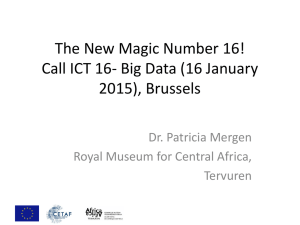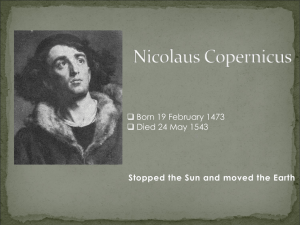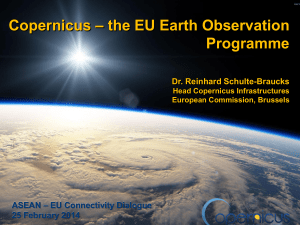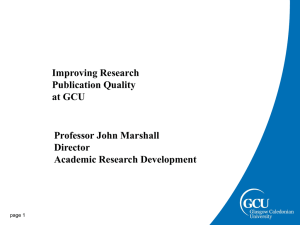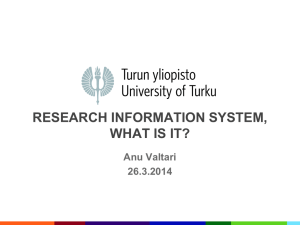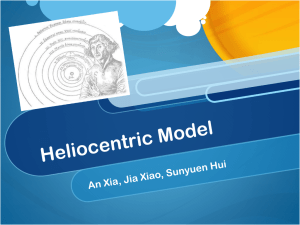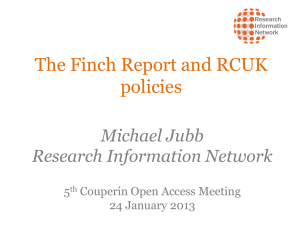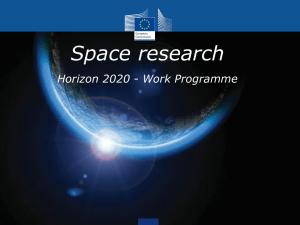Slides - OASPA
advertisement
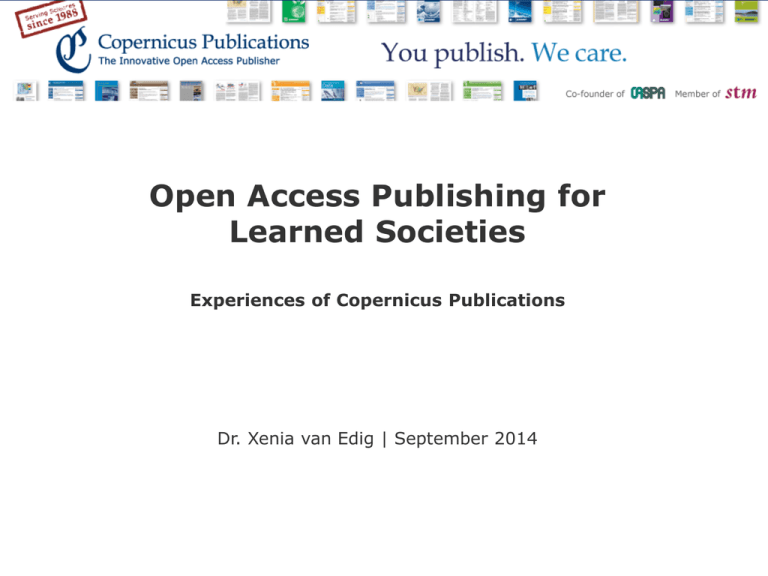
Open Access Publishing for Learned Societies Experiences of Copernicus Publications Dr. Xenia van Edig | September 2014 Overview Copernicus Publications at a Glance Business Model Financing Service Strategies for Societies Case studies History of Copernicus Publications Founding of Copernicus in 1988 as a spin-off of the Max-PlanckInstitute for Solar System Research Organization of scientific meetings & conferences since 1988 1994 Start of Copernicus Publications 2001 Start of the first open access society journal, followed by the move of the other journals towards OA 2014 Copernicus Publications publishes 36 peer-reviewed open access journals and 17 access-reviewed scientific discussion forums 31 journals owned by/affiliated to learned societies and other scientific organizations 50 Staff members, offices in Göttingen/Germany Co-founder of OASPA, member of stm, member of ORCID 169,000 pages | 7,200 papers published in 2013 Business Model Customers Learned societies Scientific institutions Groups of researchers Ownership Model 1: Copernicus is owner and publisher (5/36) Model 2: Copernicus is the publisher as licensee (30/36) Copernicus License Model Leave it to the Scientists Partner with scientific associations Let societies own titles and let them control the editorial policy Listen to scientists and tailor your services Participation and transparency for the scientists Licensing and Start-up Phase Agreement on service allowance for Copernicus Societies determine the APCs – from waivers to surplus Business is run by Copernicus, societies earn license fee Financing Article Processing Charges (APCs) Page charges heterogeneous manuscript types 10% free pages budget No extra charges for supplements, coloured figures etc. Costs for a 10-pages article: between 550 and 960 Euro Start-up Phase New journals introduction of APCs after inclusion in the Web of Science Established journals with IF introduction of APCs Time until indexation journal needs to be supported New journals: cross-financing through conferences and memberships Existing journals: maintenance of revenues Service Strategies for Societies Presentation: journal-specific web portal and libraries Identification: journal = community (e.g. society sub-group) Relation to scientists: partnership Philosophy: one-stop customized solutions & solid workmanship Publisher as a service provider! Triple OA Strategy 1 OA1 – Open Access to the Manufacture 2 OA2 – Open Access to the Review 3 OA3 – Open Access to the Publications OA1 – Open Access to the Manufacture From Submission… 1-2 personal contacts for Editors, Referees & Authors Online review system with extended personal support …to Acceptance Review Process Publication Production From Acceptance… …to Publication Project teams of 2-3 permanent staff members 1 personal contact for Authors from acceptance to publication No limitation on proof-readings Open Access Library + Alert Service (e)Archiving worldwide Indexing in databases and search engines OA2 – Open Access to the Review OA has the Potential to Enhance the Quality! Submitted manuscripts can be OA Reviewer reports can be OA Manuscripts can be discussed OA The accepted publication can be OA Innovative Approach for the Review Process (Optional) Public Peer-Review & Interactive Public Discussion Rapid access-review → publication as discussion paper Interactive public discussion: published referee comments, author comments & comments of the scientific community Paper revision & final acceptance → publication as final revised paper Designed to Foster scientific discussion; Maximize the effectiveness and transparency of scientific quality assurance; Enable rapid publication of new scientific results; Make scientific publications freely accessible. Public Peer-Review & Interactive Public Discussion 1. Submission 2. Access Review 3. Technical Corrections 4. Publication as D-paper Referees 5. Discussion Comments 5 6. Revision 7. Revised Submission 2 8. Peer-Review Completion 8 Referee Comments 9. Final Revised Publication Author 1 Editor 4 5 3 Discussion Paper 1st Stage (Discussion Forum) 6 Author 7 9 Author Comments Short Comments 2nd Stage (Journal) 5 Scientific Community Editor Final Revised Paper OA3 – Open Access to the Publications Anyone is free: to Share — to copy, distribute and transmit the work to Remix — to adapt the work Under the following conditions: Attribution. The original authors must be given credit. Article Level Metrics Usage (downloads, views) Impact (citations) Saved (bookmarks) Discussion (social media) Case Studies – Geographica Helvetica Owned by Association Suisse de Géographie (ASG) and Geographisch-Ethnographische Gesellschaft Zürich (GEGZ) Supported by Swiss Academy of Science Print-only publication till 2012 Transition (2012-2014) Subscription includes free online access Vol. 67 (2012) OA on 01 January 2013, Vol. 68 (2013) OA on 01 January 2014 Back files (since 1946): OA Immediate OA in 2015! Case Studies – Annales Geophysicae Owned by the European Geosciences Union (EGU) Published by Springer till 2001 Move to Open Access in 2008 Introduction of APCs in 2009 Case Studies – Fossil Record Owned by Museum für Naturkunde Berlin Published by Wiley till Vol. 16, Iss. 2 (2013) Impact Factor 0.913 (2013) OA since 01 January 2014 Immediate introduction of APCs Case Studies – Journal of Sensors and Sensor Systems Owned by AMA Verband für Sensorik und Messtechnik Newly launched in 2012 APCs currently waived 36 articles published Thank you very much for your attention!

